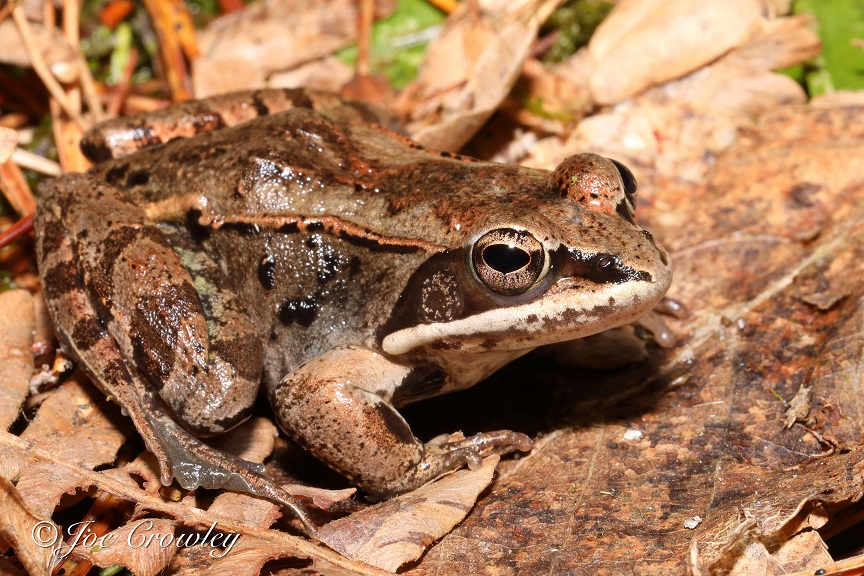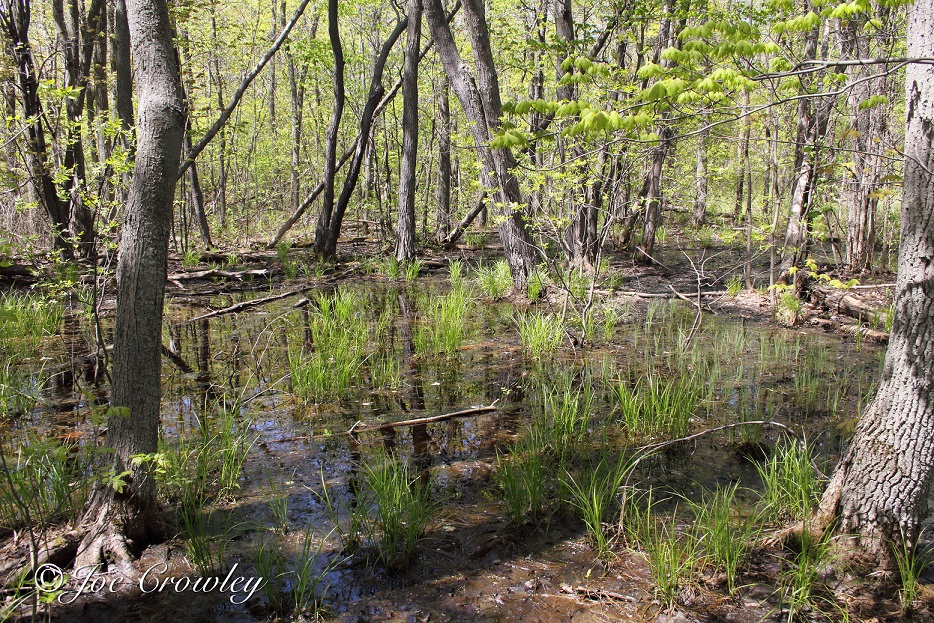The wood frog (Lithobates sylvaticus) is medium-sized, forest-dwelling frog native to North America. It is found in every province and territory in Canada. With populations north of the Arctic Circle, the wood frog’s range extends farther north than any other North American amphibian.

Description
The wood frog is a medium-sized frog that can reach a body length of over 8 cm, although most individuals are smaller than this. Females reach larger sizes than males. Wood frogs are tan, reddish brown or dark brown, sometimes with dark spotting or blotching. They have distinctive dark colouration around the eyes, commonly referred to as a mask, which extends from the tip of the nose to the shoulder. The mask contrasts sharply with a white stripe that runs along the upper lip. Wood frogs have two dorsolateral folds, which are ridges of raised skin that begin just behind the eyes and extend down the back. Dark banding is usually present on their hind legs. Individuals in northern populations often have a dark-bordered light stripe down the back. The belly is light grey to white, sometimes with a greenish or yellowish hue.
Wood frog eggs are black on top and white on the bottom. They are surrounded by two jelly envelopes. Larvae, also known as tadpoles, are typically dark grey, dark brown or black, with small brassy or gold iridescent flecking. They usually have a pale stripe along the upper jaw. Wood frog tadpoles can grow up to 6.6 cm.
Distribution and Habitat
The wood frog is found in every province and territory in Canada. Its range extends as far north as the southern shores of Hudson Bay, Ungava Bay in northern Quebec and the coast of the Arctic Ocean in northwestern Canada. With such a vast northern distribution, it is one of the few species of amphibians with the majority of its distribution in Canada. This species is also found throughout the Eastern United States as far south as Central Georgia and northwest to North Dakota, with several isolated populations extending west to Wyoming, Colorado and Idaho.
As its names implies, wood frogs live in forests. They prefer shady areas with moist soils, and they are often found in forested wetlands and swamps. At the northern extent of their range, where forests are largely absent, wood frogs are found in shrub and sedge-dominated tundra habitats. Individuals rely on leaf litter and sphagnum moss to provide moist cover and protection from predators. They breed in shallow wetlands in or near forested areas. Breeding sites are usually temporary and typically dry up in late summer, which limits the presence of predatory fish. Individuals usually return to the same breeding site each year. The larvae are aquatic and occupy these wetlands until they undergo metamorphosis, at which point the juveniles disperse into the surrounding woodlands. Hibernation sites are typically located away from the breeding ponds in upland forested habitat. Individuals hibernate in shallow depressions or burrows beneath the leaf litter. Wood frogs can travel hundreds of metres between their breeding sites, summer habitat and hibernation sites.
Did you know?
Wood frogs are “freeze-tolerant” and can survive being frozen for up to seven months. This adaptation helps them survive Canada’s long, cold winters. They achieve this by increasing the amount of urea and glucose in their cells. These “cryoprotectants” act like anti-freeze, reducing the freezing point of the fluid in the cells and preventing the cells from freezing. Scientists have studied wood frogs to inform various medical applications, such as freezing and thawing human organs for transplants.
Reproduction and Development
Wood frogs migrate to breeding sites in the early spring, often before all of the snow and ice has melted. Males call to attract females. Their call sounds like clucking ducks. The female lays up to 3,000 eggs in a gelatinous mass, and, as with most frogs, the male fertilizes the eggs as they are being laid. The eggs develop quickly and typically hatch within one to three weeks, depending on the water temperature. The aquatic larvae undergo metamorphosis and transform into terrestrial juvenile frogs after approximately seven to eighteen weeks. The length of the larval period depends on a variety of factors, including food availability, density of larvae in the wetland, the presence of predators, and water temperature. Males typically reach maturity at two to four years of age and females at three to six years of age. Individuals at northern latitudes are at the upper end of these ranges. The maximum lifespan documented for wild individuals is eight years for males and ten years for females. However, individuals only live for a maximum of four or five years in many populations.

Diet and Predation
Wood frogs are most active in moist, humid conditions, such as during and after rainfall. Juveniles and adults are sit-and-wait predators, meaning they remain still and wait for their prey to approach them. They primarily eat invertebrates, such as insects (beetles, ants, flies), spiders, snails and slugs. Tadpoles feed on particles in the water, including algae, protozoans (single-celled, animal-like organisms) and other organic matter. They will also eat amphibian eggs and larvae. Juvenile and adult wood frogs have a wide variety of predators, including mammals such as raccoons and skunks, snakes, birds, bullfrogs, fish and invertebrates such as crayfish and giant water bugs. The eggs and larvae are a source of food for many species, including a number of invertebrate species, salamanders, snakes, frogs, turtles, birds and fish.
Status and Threats
Globally, the wood frog is listed as least concern by the International Union for the Conservation of Nature. In Canada, this species is widespread and abundant, and its status has not been assessed by the Committee on the Status of Endangered Wildlife in Canada (COSEWIC). Although the wood frog is not a species at risk, threats to the species do exist and include activities that result in the loss of its habitat, such as clearing land for urban development or agriculture. In addition, environmental pollutants such as pesticides, fertilizers, industrial chemicals and road salt can reduce the growth and survival of tadpoles and cause developmental abnormalities. Other threats include mortality on roadways, clear-cutting and the spread of pathogens such as ranaviruses (viruses that can cause mass mortality in frogs).

 Share on Facebook
Share on Facebook Share on X
Share on X Share by Email
Share by Email Share on Google Classroom
Share on Google Classroom





